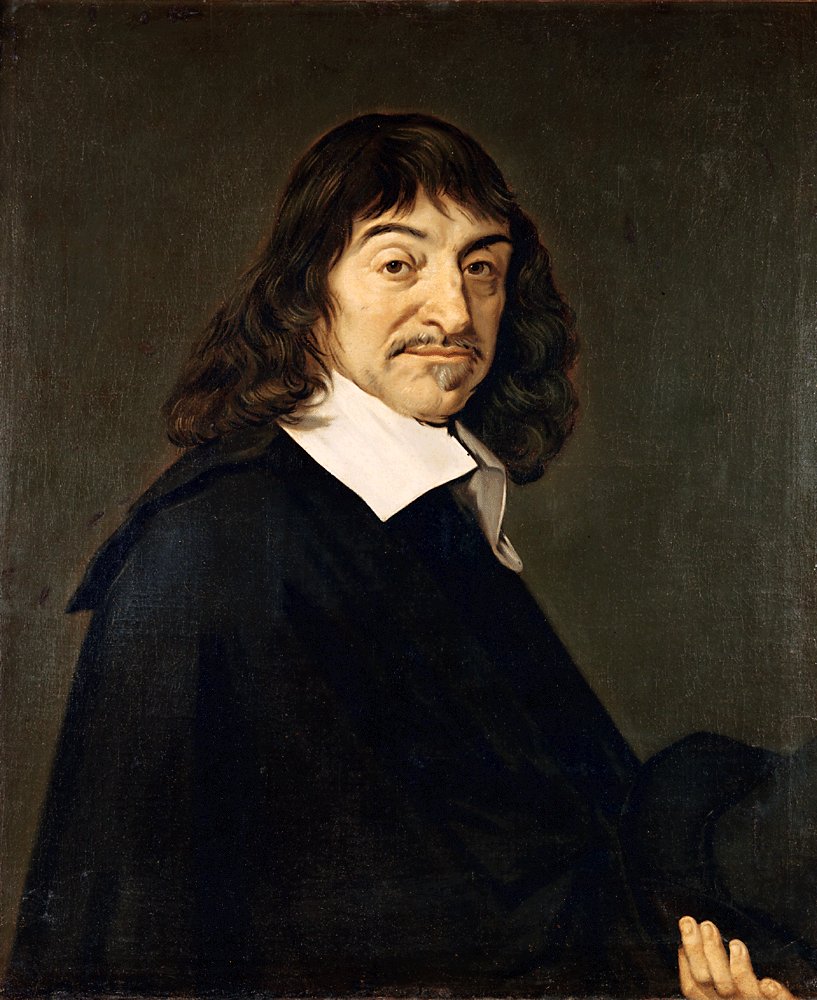2. Descartes's View of the Universe
René Descartes

René Descartes (1596-1650) stands as one of the most influential figures in modern Western intellectual history. His principal works include:
- Meditations on First Philosophy (1641)
- Discourse on the Method (1637)
- Principles of Philosophy, (1644)
- Passions of the Soul (1649).
He made significant contributions in a variety of fields:
- Cartesian Doubt and Rationalism: Famous for the phrase Cogito, ergo sum ("I think, therefore I am"), Descartes pioneered a method of systematic doubt, emphasizing reason as the path to certainty. His laid the groundwork for the Enlightenment.
- Analytic Geometry: His revolutionary invention of the Cartesian coordinate system became the foundation for the calculus and modern mathematics.
- Mind-Body Dualism: (See René Descartes: The Mind-Body Distinction)
For more details, see [@GaryHatfield2024].
Descartes's law of nature
While Descartes is most renowned for his invention of coordinate system and rationalist philosophy, his work in physics also deserves attention. In Principles of Philosophy (Hereinafter denoted as Pr) [@Descartes1985], Descartes articulated three fundamental laws of nature .
The first law of nature: each and every thing, in so far as it can, always continues in the same state; and thus what is once in motion always continues to move. (Pr.II.37)
The second law of nature: all motion is in itself rectilinear; and hence any body moving in a circle always tends to move away from the centre of the circle which it describes. (Pr. II.39)
The third law: if a body collides with another body that is stronger than itself, it loses none of its motion; but if it collides with a weaker body, it loses a quantity of motion equal to that which it imparts to the other body. (Pr. II.40)
Newton's laws of motion, formulated later, bear some resemblance to Descartes's laws, particularly the first two, which offer an early explanation of the principle of inertia. However, they lack the mathematical rigor and precision that Newton introduced.
In the third law, Descartes articulates the concept of quantity of motion (measured as the product of size and speed) and its conservation. While this third law may appear overly simplistic and perhaps insufficient, he supported it with 7 rules for calculating the speed and direction of bodies after impact. These rules, however, are flawed, primarily due to his failure to distinguish between speed (a scalar quantity) and velocity (a vector quantity)
Descartes's name is now seldom found in physics textbooks, as his work lacked sufficient rigor or was ultimately incorrect. Nonetheless, it served as a foundational stepping stone for later developments. Scientific understanding evolves with time. What is accepted as fact today may one day be completely overturned. Thus, certain aspects of Descartes's framework warrant careful consideration rather than outright dismissal.
Descartes's basic framework
In Descartes's view, the essence of matter consists in its extension
Central to Descartes's framework is the concept of motion. Motion is is a mode of matter, and all the variety in matter depends on motion (Pr.II.23). Rest is regarded as a lack of motion. The quantity of motion is determined by the product of size(extension) and speed (Pr.II.43). According to his third law, motion persists in being as it is in itself and not in relation to other things. All changes in motion result from acting on, or resisting the action of another body. And when the motion is altered, the potion of the quantity of motion is imparted to another body. Therefore, the total quantity of motion in the universe remains constant and conserved.
It is pretty obvious, but if there is nothing to move, there is no collision, no change. Descartes concluded that God is the primary cause of motion. God imparted various motions to the parts of matter when he first created the universe. Though redistributed among bodies, it has a determinant quantity and remains constant in the universe as a whole (Pr.II.36)
Additionally, Descartes rejected vacuum, arguing that all space must be filled with matter. The motion of any matter requires that the matter ahead of it be pushed forward. (PR.II.30) - In all movements a complete circuit of bodies moves simultaneously (PR.II.33). The principle resembles the modern notion of continuity for incompressible fluids.
Revisiting Descartes's framework Through the Lens of Modern Physics ?
Descartes proposed that the total quantity of motion in the universe remains constant, attributing this principle to God’s creation and preservation of motion. While his definition of quantity of motion differs from the modern concept of momentum, the broader idea aligns with the contemporary understanding that the total momentum of the universe is conserved.
Descartes's rejection of a vacuum may initially seem at odds with the common understanding of a vacuum as a region devoid of matter. However, if his rejection is reinterpreted as a denial of the existence of an absolute empty space devoid of any physical properties, his view may become acceptable. In modern physics, the vacuum is far from empty. It is a rich space that supports electromagnetic fields where momentum can be exchanged, for instance. From this perspective, Descartes’s denial of a vacuum somewhat aligns with the idea that space is never entirely devoid of physical qualities.
Thus, while some aspects of Descartes's framework are outdated, his overarching principles may be reinterpreted through the lens of modern scientist insights. Would you agree?